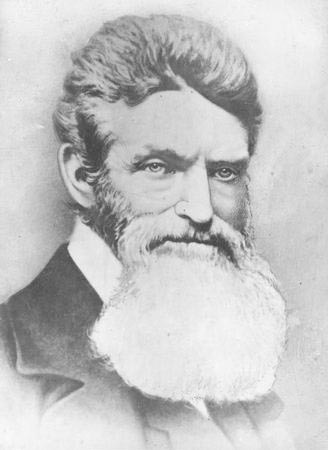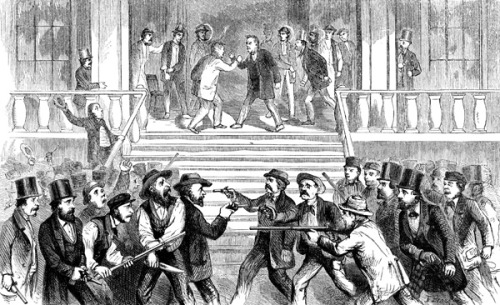peashooter85:Bleeding Kansas — A Prelude to Civil WarIn 1854 the Territory of Kansas petitioned the
peashooter85:Bleeding Kansas — A Prelude to Civil WarIn 1854 the Territory of Kansas petitioned the US Congress for statehood. Before 1854 the United States government ensured that there was an equal number of slave states and free states (Missouri Compromise of 1820). However the Kansas-Nebraska act was passed in 1854 and determined that the new state’s status should be determined by a popular vote of it’s citizens. When the polls opened a rush of pro-slavery peoples from the south flooded the polls, casting their votes in favor of slavery, and intimidating free-staters (against slavery) from voting. Even though there were only 1,500 eligible voters in Kansas, 6,000 votes were cast in favor of a pro-slavery government. They formed their own government and ran their own politicians for local government through fraud and intimidation. In reaction to this thousands of free-state northerners flooded Kansas as well, forming their own government, and running their own politicians for local government through fraud and intimidation. The political situation grew tense in Kansas, but it was only going to get worse as every firebrand in the country traveled to the territory to promote their political crusade.By November of 1854, armed militias began to form. Thousands of armed raiders known as “border ruffians” crossed into Kansas in order to harass and intimidate free state elements in the territory. In response thousands of armed abolitionists from New England flooded the state as well. Along with them was the famous abolitionist Henry Ward Beecher, who armed them with “Beecher’s Bibles” (sharps rifles). The situation became even more tense when an Ohio man named John Brown arrived in the territory in 1855. A deeply religious man and ardent supporter of abolition, John Brown was also a firebrand who preached that only armed insurrection would bring an end to slavery. Brown was not the sort of man who advocated peace or compromise, he was out for blood.The conflict erupted when on November 21st, 1855 as free stater named Charles Dow was shot by a pro-slavery settler. With that one killing everyone with a grudge and vendetta began a spree of murder, lynching, and bushwacking that consumed the state. John Brown formed his own personal army, which traveled across the state lynching and murdering anyone suspected of pro-slavery sympathies. In one incident, Brown and his men stormed a pro-slavery camp at Pottawatomie Creek where they grabbed five important pro-slavery leaders from their homes and hacked them to death with swords. At the same time border ruffians from Missouri also began to murder and loot their way across the country, terrorizing those with abolitionist tendencies. Among them was a raider named William Quantrill, who would become a feared Confederate guerrilla fighter during the Civil War.The conflict in Kansas culminated in August of 1856 when thousands of pro-slavery men formed armies and moved into Kansas. They were met by abolitionist militias who also numbered in the thousands. In that month a number of skirmishes and battles raged across Kansas as the two forces fought in open fields, armed with muskets and sometimes cannon.On August 30th, 1856, 400 border ruffians moved to capture Osawatomie, a major headquarters for the abolitionist faction, in a surprise raid. In a fierce battle John Brown attempted to hold the town, but was forced to retreat due to the ruffians superior numbers. His son Frederick was also killed in the battle. The ruffians then moved on to Lawrence, where they ransacked, looted, and burned the town. After the Battle of Osawatomie hostilities continued to rage between the ruffians and the free-staters. On September 9th, 1856 a new territorial governor was appointed named John Geary. Geary implored both sides to end the fighting, but made it clear that if they did not he would declare Kansas Territory in rebellion and request aid from Federal troops. Slowly, both began to disarm, cease hostilities, and return home. While late 1856 marks the end of “Bleeding Kansas”, raids along the Kansas/Missouri border continued up to and during the Civil War. Kansas was finally admitted as a free state on January 29th, 1861.After the “Bleeding Kansas” episode, John Brown continued his crusade against slavery. On October 16th, 1859 him and a force 18 men captured the Federal arsenal at Harper’s Ferry, Virginia. His goal was to instigate a slave uprising, which he would arm with weapons captured from the arsenal. The plan failed and Brown was hanged for treason on December 2nd, 1859. -- source link
Tumblr Blog : peashooter85.tumblr.com


